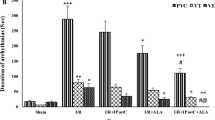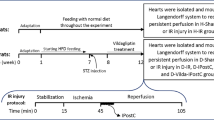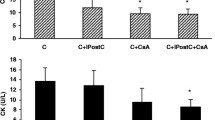Abstract
Background
Investigating the interaction of diabetes with ischemic postconditioning (IPostC)-associated cardioprotection in myocardial ischemia/reperfusion (I/R) damage is of great clinical importance. The present work was designed to determine the possible synergistic effects of alpha-lipoic acid (LA) preconditioning and IPostC on myocardial I/R damage in type-II diabetic rats through modulating autophagy, and the involvement of mitochondrial function.
Methods
High-fat diet/low dose of streptozotocin-induced type-II diabetic model with duration of 12 weeks was used in this study. LA (100 mg/kg/day) was administered orally in diabetic rats for 5 weeks before I/R. Myocardial I/R was established on Langendorff apparatus through the ligation of left anterior descending coronary artery for 35 min, then reperfusion for 60 min. IPostC was carried out immediately at the beginning of the reperfusion. At the end of the experiment, myocardial infarct size (IS), autophagy markers at both gene and protein levels, and mitochondrial ROS production and membrane potential were assessed.
Results
Combined conditioning with LA and ischemia significantly decreased the IS of diabetic hearts (P < 0.05), however, single therapies had no significant effects. LA in combination with IPostC more significantly decreased LC3 and p62 mRNA levels (P < 0.01), and LC3II/LC3I and p62 protein levels (P < 0.01). Also, this combined therapy decreased mitochondrial ROS generation and membrane depolarization (P < 0.01).
Conclusions
Pretreatment with LA in diabetic rats notably restored cardioprotection by IPostC via modulating autophagy and restoring mitochondrial function. This combined conditioning might be an effective strategy to diminish I/R damage in diabetic hearts.




Similar content being viewed by others
Data availability
The datasets used during the present work are available from the corresponding author on reasonable request.
Abbreviations
- I/R:
-
Ischemia/reperfusion
- IHD:
-
Ischemic heart disease
- IPostC:
-
Ischemic postconditioning
- LA:
-
Alpha-lipoic acid
- HOMA1-IR:
-
Homeostasis model assessment of insulin resistance
- LC3:
-
Microtubule-associated proteins 1A/1B light chain 3
- HFD/STZ:
-
High-fat diet/streptozotocin
References
Mokhtari B et al (2020) Human amniotic membrane mesenchymal stem cells-conditioned medium attenuates myocardial ischemia-reperfusion injury in rats by targeting oxidative stress. Iran J Basic Med Sci 23(11):1453–1461
Naseroleslami M et al (2020) Nesfatin-1 attenuates injury in a rat model of myocardial infarction by targeting autophagy, inflammation, and apoptosis. Arch Physiol Biochem. https://doi.org/10.1080/13813455.2020.1802486
Bayrami G et al (2017) Effect of ischemic postconditioning on myocardial function and infarct size following reperfusion injury in diabetic rats pretreated with vildagliptin. J Cardiovasc Pharmacol Ther. https://doi.org/10.1177/1074248417729881
Badalzadeh R, Azimi A, Alihemmati A, Yousefi B (2017) Chronic type-I diabetes could not impede the anti-inflammatory and anti-apoptotic effects of combined postconditioning with ischemia and cyclosporine A in myocardial reperfusion injury. J Physiol Biochem. https://doi.org/10.1007/s13105-016-0530-4
Penna C et al (2020) Effect of hyperglycaemia and diabetes on acute myocardial ischaemia–reperfusion injury and cardioprotection by ischaemic conditioning protocols. Br J Pharmacol 177(23):5312–5335
Ferdinandy P, Schulz R, Baxter GF (2007) Interaction of cardiovascular risk factors with myocardial ischemia/reperfusion injury, preconditioning, and postconditioning. Pharmacol Rev 59(4):418–458
Ferdinandy P et al (2014) Interaction of risk factors, comorbidities, and comedications with ischemia/reperfusion injury and cardioprotection by preconditioning, postconditioning, and remote conditioning. Pharmacol Rev 66(4):1142–1174
Bayrami G et al (2018) Combination of vildagliptin and ischemic postconditioning in diabetic hearts as a working strategy to reduce myocardial reperfusion injury by restoring mitochondrial function and autophagic activity. Adv Pharm Bull 8(2):319–329
Mokhtari B, Badalzadeh R, Aboutaleb N (2021) Modulation of autophagy as the target of mesenchymal stem cells-derived conditioned medium in rat model of myocardial ischemia/reperfusion injury. Mol Biol Rep 48(4):3337–3348
Ouyang C, You J, Xie Z (2014) The interplay between autophagy and apoptosis in the diabetic heart. J Mol Cell Cardiol 71:71–80
Dewanjee S et al (2021) Autophagy in the diabetic heart: a potential pharmacotherapeutic target in diabetic cardiomyopathy. Ageing Res Rev 68:101338
Mokhtari B, Badalzadeh R (2021) The potentials of distinct functions of autophagy to be targeted for attenuation of myocardial ischemia/reperfusion injury in preclinical studies: an up-to-date review. J Physiol Biochem 77(3):377–404
Schiattarella GG, Hill JA (2016) Therapeutic targeting of autophagy in cardiovascular disease. J Mol Cell Cardiol 95:86–93
Takagi H, Matsui Y, Sadoshima J (2007) The role of autophagy in mediating cell survival and death during ischemia and reperfusion in the heart. Antioxid Redox Signal 9(9):1373–1382
Yu L et al (2017) Melatonin ameliorates myocardial ischemia/reperfusion injury in type 1 diabetic rats by preserving mitochondrial function: role of AMPK-PGC-1α-SIRT3 signaling. Sci Rep 7(1):1–13
Ajami M et al (2011) Expression of Bcl-2 and Bax after hippocampal ischemia in DHA+ EPA treated rats. Neurol Sci 32(5):811–818
Ajami M et al (2013) Effect of DHA+ EPA on oxidative stress and apoptosis induced by ischemia-reperfusion in rat kidneys. Fund Clin Pharmacol 27(6):593–602
Ghibu S et al (2009) Antioxidant properties of an endogenous thiol: alpha-lipoic acid, useful in the prevention of cardiovascular diseases. J Cardiovasc Pharmacol 54(5):391–398
Li C-J et al (2009) Attenuation of myocardial apoptosis by alpha-lipoic acid through suppression of mitochondrial oxidative stress to reduce diabetic cardiomyopathy. Chin Med J 122(21):2580–2586
Ding Y et al (2021) Effects of lipoic acid on ischemia-reperfusion injury. Oxid Med Cell Longev. https://doi.org/10.1155/2021/5093216
Cao X et al (2013) Alpha-lipoic acid protects cardiomyocytes against hypoxia/reoxygenation injury by inhibiting autophagy. Biochem Biophys Res Commun 441(4):935–940
Ghelani H, Razmovski-Naumovski V, Nammi S (2017) Chronic treatment of (R)‐α‐lipoic acid reduces blood glucose and lipid levels in high‐fat diet and low‐dose streptozotocin‐induced metabolic syndrome and type 2 diabetes in Sprague‐Dawley rats. Pharmacol Res Perspect. https://doi.org/10.1002/prp2.306
Miki T et al (2012) Effects of diabetes on myocardial infarct size and cardioprotection by preconditioning and postconditioning. Cardiovas Diabetol 11(1):1–13
Srinivasan K et al (2005) Combination of high-fat diet-fed and low-dose streptozotocin-treated rat: a model for type 2 diabetes and pharmacological screening. Pharmacol Res 52(4):313–320
Hosseini L, Vafaee MS, Badalzadeh R (2020) Melatonin and nicotinamide mononucleotide attenuate myocardial ischemia/reperfusion injury via modulation of mitochondrial function and hemodynamic parameters in aged rats. J Cardiovasc Pharmacol Ther 25(3):240–250
Geloneze B et al (2009) HOMA1-IR and HOMA2-IR indexes in identifying insulin resistance and metabolic syndrome: Brazilian Metabolic Syndrome Study (BRAMS). Arq Bras Endocrinol Metab 53(2):281–287
Zhao D, Yang J, Yang L (2017) Insights for oxidative stress and mTOR signaling in myocardial ischemia/reperfusion injury under diabetes. Oxid Med Cell Longev. https://doi.org/10.1155/2017/6437467
Alegria JR et al (2007) Infarct size, ejection fraction, and mortality in diabetic patients with acute myocardial infarction treated with thrombolytic therapy. Am Heart J 154(4):743–750
Hsu H-C et al (2016) High-fat diet induces cardiomyocyte apoptosis via the inhibition of autophagy. Eur J Nutr 55(7):2245–2254
Hayat SA et al (2004) Diabetic cardiomyopathy: mechanisms, diagnosis and treatment. Clin Sci 107(6):539–557
Xuan F et al (2017) 17-methoxyl-7-hydroxy-benzene-furanchalcone ameliorates myocardial ischemia/reperfusion injury in rat by inhibiting apoptosis and autophagy via the PI3K–Akt signal pathway. Cardiovasc Toxicol 17(1):79–87
Aghaei M et al (2019) Targeting autophagy in cardiac ischemia/reperfusion injury: a novel therapeutic strategy. J Cell Physiol 234(10):16768–16778
Sciarretta S et al (2015) Boosting autophagy in the diabetic heart: a translational perspective. Cardiovasc Diagn Ther 5(5):394–402
Gottlieb RA, Mentzer RM Jr (2010) Autophagy during cardiac stress: joys and frustrations of autophagy. Annu Rev Physiol 72:45–59
Kobayashi S, Liang Q (2015) Autophagy and mitophagy in diabetic cardiomyopathy. Biochim Biophys Acta Mol Basis Dis 1852(2):252–261
Gonzalez CD et al (2011) The emerging role of autophagy in the pathophysiology of diabetes mellitus. Autophagy 7(1):2–11
Acknowledgements
The authors appreciate the National Institute for Medical Research Development (NIMAD) for their supports, also the help of Dr. Nasrin Abolhasanpour in providing information about some parts of the initial draft of the manuscript.
Funding
The author(s) disclosed receipt of the following financial support for the research, authorship, and/or publication of this article: This work has been supported by a grant from National Institute for Medical Research Development, Iran (NIMAD; grant No. 957279), and direct contribution of Molecular Medicine Research Center, Tabriz University of Medical Sciences, Iran (No: 66545).
Author information
Authors and Affiliations
Contributions
BM and MA performed the experimental tests, and gathered and analyzed the data. BM wrote the manuscript. AA and AJ contributed in interpretation of the results. RB did the study design, supervised the whole project, and contributed in interpretation of the results. RB and BM critically revised the manuscript and finalized the manuscript. All gave final approval and agree to be accountable for all aspects of work ensuring integrity and accuracy. The authors declare that all data were generated in-house and that no paper mill was used.
Corresponding author
Ethics declarations
Conflict of interest
The author(s) declared no potential conflicts of interest with respect to the research, authorship, and/or publication of this article.
Ethical approval
All experimental protocols and procedures were approved by the Institutional Animal Ethical Committee at the Faculty of Medicine of Tabriz University of Medical Sciences (Ethical code: IR.NIMAD.REC.1396.029).
Additional information
Publisher’s Note
Springer Nature remains neutral with regard to jurisdictional claims in published maps and institutional affiliations.
Rights and permissions
About this article
Cite this article
Mokhtari, B., Abdoli-Shadbad, M., Alihemmati, A. et al. Alpha-lipoic acid preconditioning plus ischemic postconditioning provides additional protection against myocardial reperfusion injury of diabetic rats: modulation of autophagy and mitochondrial function. Mol Biol Rep 49, 1773–1782 (2022). https://doi.org/10.1007/s11033-021-06987-6
Received:
Accepted:
Published:
Issue Date:
DOI: https://doi.org/10.1007/s11033-021-06987-6




